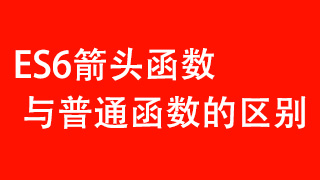es6箭头函数与普通函数的区别
日期:2018-11-08
来源:程序思维浏览:3704次
今天和大家说说es6的箭头函数和普通函数的区别,这也是面试当中常问的问题。

1.es5的function函数在运行时绑定到this函数,箭头函数在定义时初始化绑定this。
let obj = {
a: "hello",
f: () => {
console.log(this.a); // "undefined"
console.log(this); // Window
}
}
let obj = {
a: "hello",
f: function () {
console.log(this.a); // "hello"
console.log(this); // obj
}
}
obj.f();
2.由于this已经被绑定在词法层面,通过call()或apply()方法调用函数只是传入参数,对此没有影响。
let obj = {
value: "hello",
add: function(str) {
console.log(this); //obj
var f = (v) => v + this.value;
return f(str);
},
addCall: function(str) {
console.log(this); //obj
var f = function (v) {
return v + this.value;
};
var newObj = {value: "good"};
return f.call(newObj, str);
},
addArrowCall: function(str) {
console.log(this); //obj
var f = (v) => v + this.value;
var newObj = {value: "good"};
return f.call(newObj, str);
}
}
console.log(obj.add("Ynqc ")); // Ynqc hello
console.log(obj.addCall("Ynqc ")); // Ynqc good
console.log(obj.addArrowCall("Ynqc ")); // Ynqc hello
3.箭头函数不绑定arguments
var f = (...args) => {
//console.log(arguments); //Uncaught ReferenceError
console.log(args); //["hello"]
}
function f() {
console.log(arguments); //Arguments ["hello", callee: ƒ, Symbol(Symbol.iterator): ƒ]
}
f("hello");
4.箭头函数不能用作构造函数,和 new 一起用就会抛出错误
var f = () => {}
console.log(newF); //Uncaught TypeError: f is not a constructor
function f() {}
var newF = new f();
console.log(newF); // f()
5.箭头函数没有原型属性。
var arrowF = () => {}
console.log(arrowF.prototype) //undefined
function f() {}
console.log(f.prototype) //{constructor: ƒ}
6.如果箭头函数返回一个对象,则:
var arrowF = () => ({
ynqc: "hello"
});
function f() {
return {
ynqc: "hello"
}
}
console.log(f()); //{ynqc: "hello"}

1.es5的function函数在运行时绑定到this函数,箭头函数在定义时初始化绑定this。
let obj = {
a: "hello",
f: () => {
console.log(this.a); // "undefined"
console.log(this); // Window
}
}
let obj = {
a: "hello",
f: function () {
console.log(this.a); // "hello"
console.log(this); // obj
}
}
obj.f();
2.由于this已经被绑定在词法层面,通过call()或apply()方法调用函数只是传入参数,对此没有影响。
let obj = {
value: "hello",
add: function(str) {
console.log(this); //obj
var f = (v) => v + this.value;
return f(str);
},
addCall: function(str) {
console.log(this); //obj
var f = function (v) {
return v + this.value;
};
var newObj = {value: "good"};
return f.call(newObj, str);
},
addArrowCall: function(str) {
console.log(this); //obj
var f = (v) => v + this.value;
var newObj = {value: "good"};
return f.call(newObj, str);
}
}
console.log(obj.add("Ynqc ")); // Ynqc hello
console.log(obj.addCall("Ynqc ")); // Ynqc good
console.log(obj.addArrowCall("Ynqc ")); // Ynqc hello
3.箭头函数不绑定arguments
var f = (...args) => {
//console.log(arguments); //Uncaught ReferenceError
console.log(args); //["hello"]
}
function f() {
console.log(arguments); //Arguments ["hello", callee: ƒ, Symbol(Symbol.iterator): ƒ]
}
f("hello");
4.箭头函数不能用作构造函数,和 new 一起用就会抛出错误
var f = () => {}
console.log(newF); //Uncaught TypeError: f is not a constructor
function f() {}
var newF = new f();
console.log(newF); // f()
5.箭头函数没有原型属性。
var arrowF = () => {}
console.log(arrowF.prototype) //undefined
function f() {}
console.log(f.prototype) //{constructor: ƒ}
6.如果箭头函数返回一个对象,则:
var arrowF = () => ({
ynqc: "hello"
});
function f() {
return {
ynqc: "hello"
}
}
console.log(f()); //{ynqc: "hello"}
- 上一篇:ajax全局数据请求拦截怎么做
- 下一篇:前端必问面试题汇总附音频解析
精品好课

